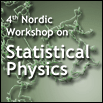Speaker
Prof.
Bernhard Mehlig
(University of Gothenburg)
Description
The dynamics of turbulent aerosols (suspensions of particles
in turbulent flows) is important for the understanding of
key processes in the Natural Sciences and Technology
(turbulent rain clouds, planet formation in circumstellar
accretion disks, and fibre suspensions, to name but a few).
In recent years our understanding of the dynamics of
turbulent aerosols has increased substantially, by means of
direct numerical simulations, and by model calculations -
often based on idealised models of the underlying flow and
of the interactions between the flow and the particles. The
analysis of models of spherical particles moving subject to
Stokes force in random flows (with the appropriate
statistics) has contributed to our understanding of the
fundamental mechanisms giving rise to spatial clustering and
collisions between spherical point particles suspended in
such flows.
Less is known about the dynamics of asymmetrical,
non-spherical particles, despite the fact that non-spherical
particles are of interest in a wide range of contexts. For
example, tumbling ice particles in turbulent clouds may play
an important role in cloud-particle interactions. Dust
grains in circumstellar accretion disks are not spherically
symmetric and the relative orientation at which such grains
collide may have important consequences for the outcome of
the collision process. The competition between tumbling and
rotational diffusion of non-spherical particles determines
the rheology of fibrous suspensions. Singularities in the
orientation field of non-spherical particles determine the
orientational patterns of rheoscopic suspensions.
Recently, the tumbling rate of small particles in turbulent
flows was investigated experimentally and by means of direct
numerical simulations. It was found that disks tumble, on
average, at a much higher rate than rods, and this fact was
related to the observation that rods tend to preferentially
align with the vorticity of the flow.
We have analysed the tumbling of small non-spherical
particles in random flows with finite correlation length and
time. We compute the orientational dynamics systematically
in terms of a perturbation expansion in the Kubo number.
This makes it possible to address the following questions.
First, how and when do disks and rods tumble differently?
How does the nature of the Lagrangian flow statistics
influence the tumbling? What is the effect of inertia on
the orientational dynamics of small particles? We compare
the results to those of recent experimental and numerical
studies of non-spherical particles tumbling in turbulent flows.

